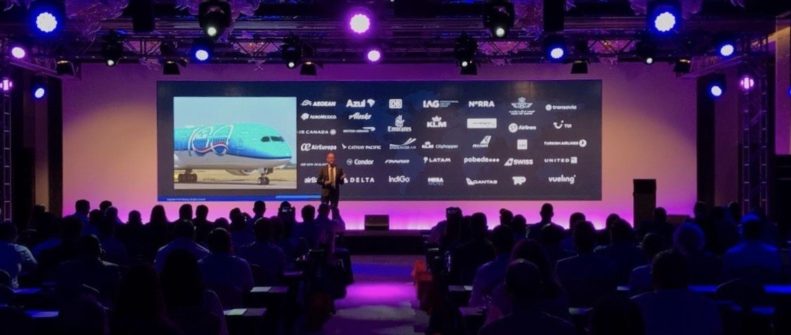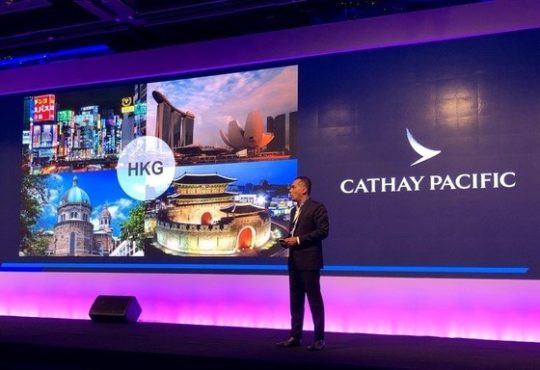
FRM News Flash – November 2019
A Successful Jeppesen Crew Connect Users Conference
This year’s annual ‘users conference’ was, once again, a very successful event. Over 200 crew management professionals gathered in Dubai at the end of October to interact over a four-day period. The conference was graciously co-hosted by Emirates. These were intense days packed with demos, customer presentations, workshops, experience-sharing and networking and was a lot of fun. High on the agenda for many operators this year were topics of optimization and process integration.
In terms of fatigue risk management, Arvid Müllern-Aspegren held a dedicated session  around applied fatigue risk control, and several operators addressed in the presentations their experiences from using BAM proactively for reducing risk in the crew management process. The greatly appreciated and detailed presentation by Cathay Pacific (picture) explained their usage of BAM for influencing the pairing optimization process.
around applied fatigue risk control, and several operators addressed in the presentations their experiences from using BAM proactively for reducing risk in the crew management process. The greatly appreciated and detailed presentation by Cathay Pacific (picture) explained their usage of BAM for influencing the pairing optimization process.
All in all, customers and staff were in agreement that it was a great and highly valuable event, and we now all eagerly await and look forward to next years’ conference, which will be co-hosted with Air Canada.
For more information about these 'by-invitation-only' events, please contact your Jeppesen representative. Please find here more information about Jeppesen Crew Pairing and the Boeing Alertness Model.
Could it be any easier?
 CrewAlert TOD, available for iOS and Android, has gotten off to a flying start now used fort collecting data from crew traveling the world. With a broad uptake across different types of operations and regions, it will become possible to compile industry averages benchmarking fatigue levels, sleep loss, usage of controlled rest and much more, enabling a more comprehensive follow-up over the true experienced fatigue risk.
CrewAlert TOD, available for iOS and Android, has gotten off to a flying start now used fort collecting data from crew traveling the world. With a broad uptake across different types of operations and regions, it will become possible to compile industry averages benchmarking fatigue levels, sleep loss, usage of controlled rest and much more, enabling a more comprehensive follow-up over the true experienced fatigue risk.
Is your organisation interested in improved situational awareness to the the one provided by only (a few) fatigue reports? If so, please contact us here to discuss setting up a secure and simple continuous data flow. It could not be easier.
Special Issue of Industry Health
The Working Time Society (WTS) has recently developed and synthesized material for a special issue of Industrial Health, that distills current knowledge into consensus statements and best practices. 
The special issue is a reflection of the WTS mission to “…foster the scientific progress, knowledge and development of occupational health and related subjects on an international basis”, with the intent to inform professional communities on the current state of the science regarding working time and provide useful information to stakeholders (practitioners, policy makers, and workers) on topics that affect the worker community. The issue is meant to provide a foundation of information and concepts for anyone involved in the conversation around working time, and to be consulted when developing, adjusting, or negotiating working time arrangements, policies, practices and/or regulations. You can find the full issue for free access via this link. Enjoy.
Dust the Rust?

When planning airline crew, the regulatory flight and duty time limits (FTLs) are implemented as hard ’rules’ that the crew planning processes need to comply with. If you think of it, these FTLs are really just simplified fatigue models, which for the most part assume that more work necessarily results in higher fatigue risk. Even after being updated in recent FRM-work done in many regions, they remain quite misaligned with the scientific position of performance variability, especially regarding work during night. This misalignment, in combination with airlines striving for high crew efficiency, may sometimes results in higher fatigue risk than necessary, not lower.
Increasingly, regulators are adopting the intent of ICAO, allowing individual operators to improve upon flight safety, while maintaining efficiency. This by granting greater ’operational flexibility’ (chapter 1.1 in the FRMS Implementation Guide) using alternative rules, when an equivalent level of safety can be demonstrated. But how can operators do so in a practical, systematic manner based on established science? Take a look at this paper from Jeppesen describing the methodology for ‘dusting off’ the rusty rules, improving the alignment with human physiology.
At Jeppesen we have the tools and the expertise to assist you identifying suitable rule relaxations. Drop us an email here if you are interested exploring this further.
Meet up with the Jeppesen experts:
NOV 12-13: EBAA, Cologne
NOV 20-21: FRM Training Course, Montreal
MAR 16-19: Managing Fatigue 2020, Freemantle
APR 20-22: AGIFORS, Istanbul
MAY 12-13: FRM Training Course, Montreal
jeppesen.com/frm
+46 31 720 81 00
Send us an Email
A Successful Jeppesen Crew Connect Users Conference
This year’s annual ‘users conference’ was, once again, a very successful event. Over 200 crew management professionals gathered in Dubai at the end of October to interact over a four-day period. The conference was graciously co-hosted by Emirates. These were intense days packed with demos, customer presentations, workshops, experience-sharing and networking and was a lot of fun. High on the agenda for many operators this year were topics of optimization and process integration.
In terms of fatigue risk management, Arvid Müllern-Aspegren held a dedicated session  around applied fatigue risk control, and several operators addressed in the presentations their experiences from using BAM proactively for reducing risk in the crew management process. The greatly appreciated and detailed presentation by Cathay Pacific (picture) explained their usage of BAM for influencing the pairing optimization process.
around applied fatigue risk control, and several operators addressed in the presentations their experiences from using BAM proactively for reducing risk in the crew management process. The greatly appreciated and detailed presentation by Cathay Pacific (picture) explained their usage of BAM for influencing the pairing optimization process.
All in all, customers and staff were in agreement that it was a great and highly valuable event, and we now all eagerly await and look forward to next years’ conference, which will be co-hosted with Air Canada.
For more information about these 'by-invitation-only' events, please contact your Jeppesen representative. Please find here more information about Jeppesen Crew Pairing and the Boeing Alertness Model.
Could it be any easier?
 CrewAlert TOD, available for iOS and Android, has gotten off to a flying start now used fort collecting data from crew traveling the world. With a broad uptake across different types of operations and regions, it will become possible to compile industry averages benchmarking fatigue levels, sleep loss, usage of controlled rest and much more, enabling a more comprehensive follow-up over the true experienced fatigue risk.
CrewAlert TOD, available for iOS and Android, has gotten off to a flying start now used fort collecting data from crew traveling the world. With a broad uptake across different types of operations and regions, it will become possible to compile industry averages benchmarking fatigue levels, sleep loss, usage of controlled rest and much more, enabling a more comprehensive follow-up over the true experienced fatigue risk.
Is your organisation interested in improved situational awareness to the the one provided by only (a few) fatigue reports? If so, please contact us here to discuss setting up a secure and simple continuous data flow. It could not be easier.
Special Issue of Industry Health
The Working Time Society (WTS) has recently developed and synthesized material for a special issue of Industrial Health, that distills current knowledge into consensus statements and best practices. 
The special issue is a reflection of the WTS mission to “…foster the scientific progress, knowledge and development of occupational health and related subjects on an international basis”, with the intent to inform professional communities on the current state of the science regarding working time and provide useful information to stakeholders (practitioners, policy makers, and workers) on topics that affect the worker community. The issue is meant to provide a foundation of information and concepts for anyone involved in the conversation around working time, and to be consulted when developing, adjusting, or negotiating working time arrangements, policies, practices and/or regulations. You can find the full issue for free access via this link. Enjoy.
Dust the Rust?

When planning airline crew, the regulatory flight and duty time limits (FTLs) are implemented as hard ’rules’ that the crew planning processes need to comply with. If you think of it, these FTLs are really just simplified fatigue models, which for the most part assume that more work necessarily results in higher fatigue risk. Even after being updated in recent FRM-work done in many regions, they remain quite misaligned with the scientific position of performance variability, especially regarding work during night. This misalignment, in combination with airlines striving for high crew efficiency, may sometimes results in higher fatigue risk than necessary, not lower.
Increasingly, regulators are adopting the intent of ICAO, allowing individual operators to improve upon flight safety, while maintaining efficiency. This by granting greater ’operational flexibility’ (chapter 1.1 in the FRMS Implementation Guide) using alternative rules, when an equivalent level of safety can be demonstrated. But how can operators do so in a practical, systematic manner based on established science? Take a look at this paper from Jeppesen describing the methodology for ‘dusting off’ the rusty rules, improving the alignment with human physiology.
At Jeppesen we have the tools and the expertise to assist you identifying suitable rule relaxations. Drop us an email here if you are interested exploring this further.
Meet up with the Jeppesen experts:
NOV 12-13: EBAA, Cologne
NOV 20-21: FRM Training Course, Montreal
MAR 16-19: Managing Fatigue 2020, Freemantle
APR 20-22: AGIFORS, Istanbul
MAY 12-13: FRM Training Course, Montreal
| jeppesen.com/frm | +46 31 720 81 00 | Send us an Email |

